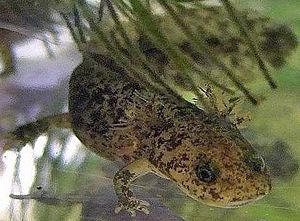Asiatic salamander facts for kids
Quick facts for kids Asiatic salamanders |
|
|---|---|
 |
|
| Hynobius kimurae | |
| Scientific classification | |
| Kingdom: | |
| Phylum: | |
| Class: | |
| Order: | |
| Suborder: | |
| Family: |
Hynobiidae
|
The Asiatic salamanders are a special group of salamanders found all over Asia. They belong to the family called Hynobiidae. These salamanders are considered a very old type of amphibian.
Unlike many other salamanders, Asiatic salamanders use a unique way to have babies. They use something called "external fertilization." This means the female lays her eggs in a special sac, and then the male releases his sperm onto the eggs outside her body.
Asiatic salamanders are closely related to the giant salamanders. Together, they form a larger group called the Cryptobranchoidea. About half of all known Asiatic salamander species live only in Japan.
What are Asiatic Salamanders?
Asiatic salamanders are a family of amphibians known as Hynobiidae. They are part of the larger group of salamanders and newts. These animals are often small to medium-sized. They have smooth, moist skin and usually live near water.
They are found in many parts of Asia. This includes countries like China, Japan, Korea, and parts of Russia. They prefer cool, damp places. You might find them in forests, near streams, or under rocks.
Reproduction and Life Cycle
Asiatic salamanders have a unique way of reproducing. When it's time to lay eggs, the female salamander creates a jelly-like egg sac. This sac holds many small eggs. She usually attaches this sac to plants or rocks in the water.
After the female lays the egg sac, the male salamander comes along. He releases his sperm directly onto the eggs in the sac. This is called external fertilization. The eggs then develop into larvae, which look like tiny versions of the adults but live in water. They have gills to breathe underwater.
As the larvae grow, they slowly change. They lose their gills and develop lungs. This process is called metamorphosis. Once they have lungs, they can move onto land. They will then live as adult salamanders.
Where They Live
Asiatic salamanders live in many different habitats across Asia. They are often found in cool, temperate regions. Many species live in mountainous areas. They prefer places with plenty of moisture.
You can find them in forests, under logs, or in leaf litter. They also live near streams, ponds, and other water sources. The water is important for their eggs and young larvae. Some species are found at high altitudes. Others live in lowland areas.
Japan is a very important place for these salamanders. Almost half of all known Hynobiid species live only in Japan. This makes Japan a special hotspot for their diversity.
See also
 In Spanish: Salamandras asiáticas para niños
In Spanish: Salamandras asiáticas para niños

